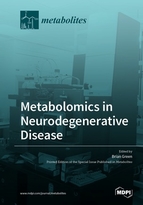Metabolomics in Neurodegenerative Disease
A special issue of Metabolites (ISSN 2218-1989). This special issue belongs to the section "Endocrinology and Clinical Metabolic Research".
Deadline for manuscript submissions: closed (31 December 2018) | Viewed by 50948
Special Issue Editor
Special Issue Information
Dear Colleagues,
The range of human neurodegenerative diseases continues to pose significant unmet medical needs for societies around the world. Examples of common neurodegenerative diseases include multiple sclerosis, amyotrophic lateral sclerosis, age-related macular degeneration, vascular dementia, Alzheimer's, Parkinson's, and Huntington's disease. The progressive and terminal nature of these conditions places a considerable personal burden on the individual affected. Additionally, there is a growing economic and public health burden which forces governments and health services to make difficult choices concerning the allocation of medical resources. Tens of millions of people are indiscriminately affected by various dementias which are rising at an alarming rate. There are no cures for many conditions and it is clear that treatments applied as early as possible could greatly improve outcomes for patients. Therefore, new disease classification and diagnostic tools should be a key priority. Metabolomics represents a relatively new field of analytical science which can be extremely useful in the early diagnosis of disease. The relatively unique feature of metabolites is that they sit at the intersection between the genetic background of an organism and its environment. Since many neurodegenerative diseases are not genetically inherited (instead having range of known genetic risk factors and also a large number of unknown environmental triggers) metabolomics offers great promise for the discovery of new, biologically, and clinically relevant biomarkers for neurodegenerative disorders. It is already bringing forward new knowledge in terms of the mechanisms of neurodegenerative disease.
The present Special Issue of Metabolites presents a collection of cutting-edge studies and review articles demonstrating the application of metabolomics for the investigation of neurodegenerative disease.
Dr. Brian D. Green
Guest Editor
Manuscript Submission Information
Manuscripts should be submitted online at www.mdpi.com by registering and logging in to this website. Once you are registered, click here to go to the submission form. Manuscripts can be submitted until the deadline. All submissions that pass pre-check are peer-reviewed. Accepted papers will be published continuously in the journal (as soon as accepted) and will be listed together on the special issue website. Research articles, review articles as well as short communications are invited. For planned papers, a title and short abstract (about 100 words) can be sent to the Editorial Office for announcement on this website.
Submitted manuscripts should not have been published previously, nor be under consideration for publication elsewhere (except conference proceedings papers). All manuscripts are thoroughly refereed through a single-blind peer-review process. A guide for authors and other relevant information for submission of manuscripts is available on the Instructions for Authors page. Metabolites is an international peer-reviewed open access monthly journal published by MDPI.
Please visit the Instructions for Authors page before submitting a manuscript. The Article Processing Charge (APC) for publication in this open access journal is 2700 CHF (Swiss Francs). Submitted papers should be well formatted and use good English. Authors may use MDPI's English editing service prior to publication or during author revisions.
Keywords
- metabolomics Parkinson's disease
- metabolomics Huntington's disease
- metabolomics Alzheimer's disease
- disease multiple sclerosis
- metabolomics amyotrophic lateral sclerosis
- metabolomics vascular dementia







